Ultimate Barbell Guide: All To Know Before Buying
Author:
Reviewed by:
(Head of Sport Science, 20 years of Oly Lifting experience, PhD Sport Science)
Unlock your full potential by engaging with our experts and community! Have questions about your fitness journey or looking for expert advice on weightlifting techniques? Don’t hesitate — leave a comment below and Ihor Shymechko will provide a personalized answer and insights to help you reach your goals.
Torokhtiy is reader-supported. Some links are affiliate links, and we may earn a commission at no extra cost to you. See our disclosure page for details.
Gym membership can be expensive, and not everyone wants to leave their house every time they want to work out, so it makes sense so many people opt for home gyms instead of commercial ones. The barbell is the star of the show when it comes to weightlifting, and if you’re still working out without it, we’re about to change your mind.
Why does the barbell matter so much? Isn’t it just a piece of metal? Well… Not quite. The barbell is the foundation of your lifting routine, so you want to make sure you choose correctly. The right barbell will provide grip, durability, and balance you need to perform your exercises safely. A subpar barbell can compromise your form and even lead to injuries.
So, what should you look for and how can you make the right choice? That’s easy – stick around and we’’ll show you!
Let’s gym.
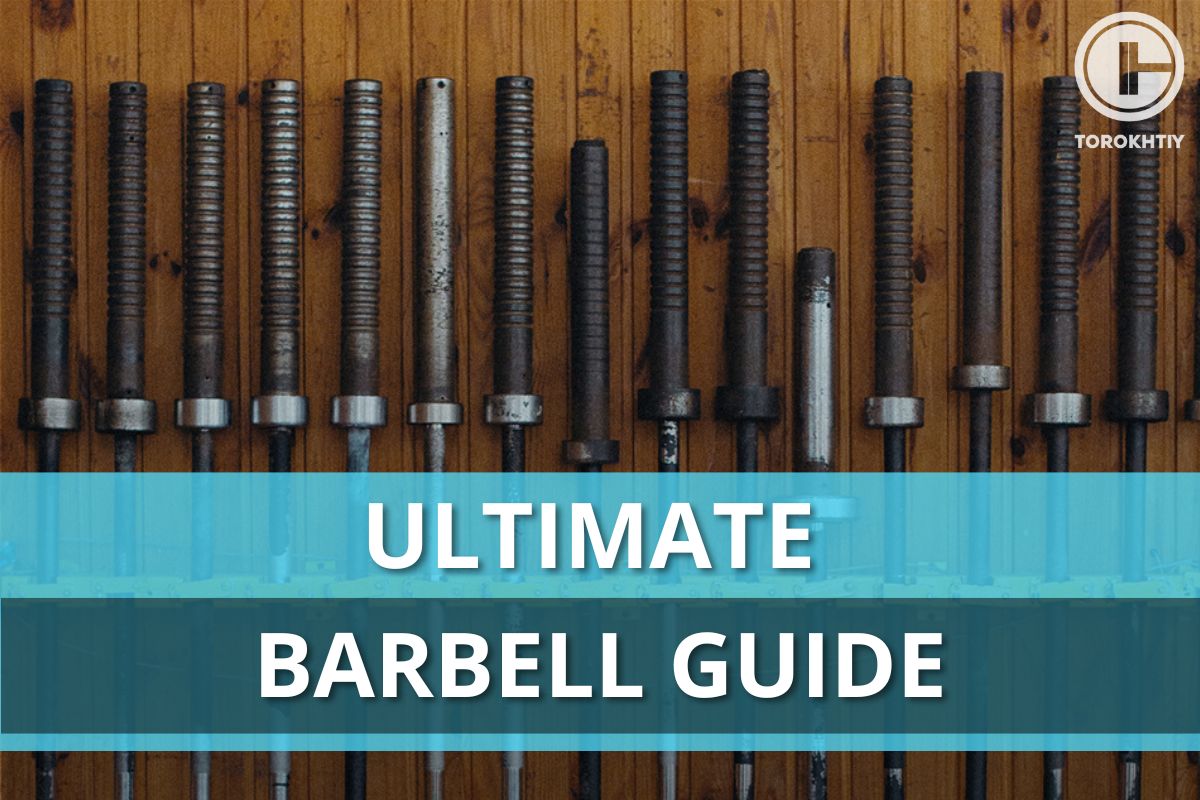
6 Main Types of Barbells
Barbells come in many different types, and each of them is designed for a specific purpose. Before you choose what brand and style of a barbell you want, it’s good to get familiar with the main types so you know what to expect.
1. Standard
Standard bar, which is often called a “straight bar,” is an all-purpose barbell. Nowadays we can fairly say that in most gyms and boxes the “new” standard is the olympic barbell. Usually, it weighs around 20 kg and has a shaft diameter of 28mm. Since these bars are so versatile, they’re used in both home gyms and fitness centers for a wide range of exercises.
You can see shorter and lighter barbells with smaller 1” sleeve diameters, but they are not so common anymore in the gym, however still available for buy. Keep in mind they require specific plates as well.
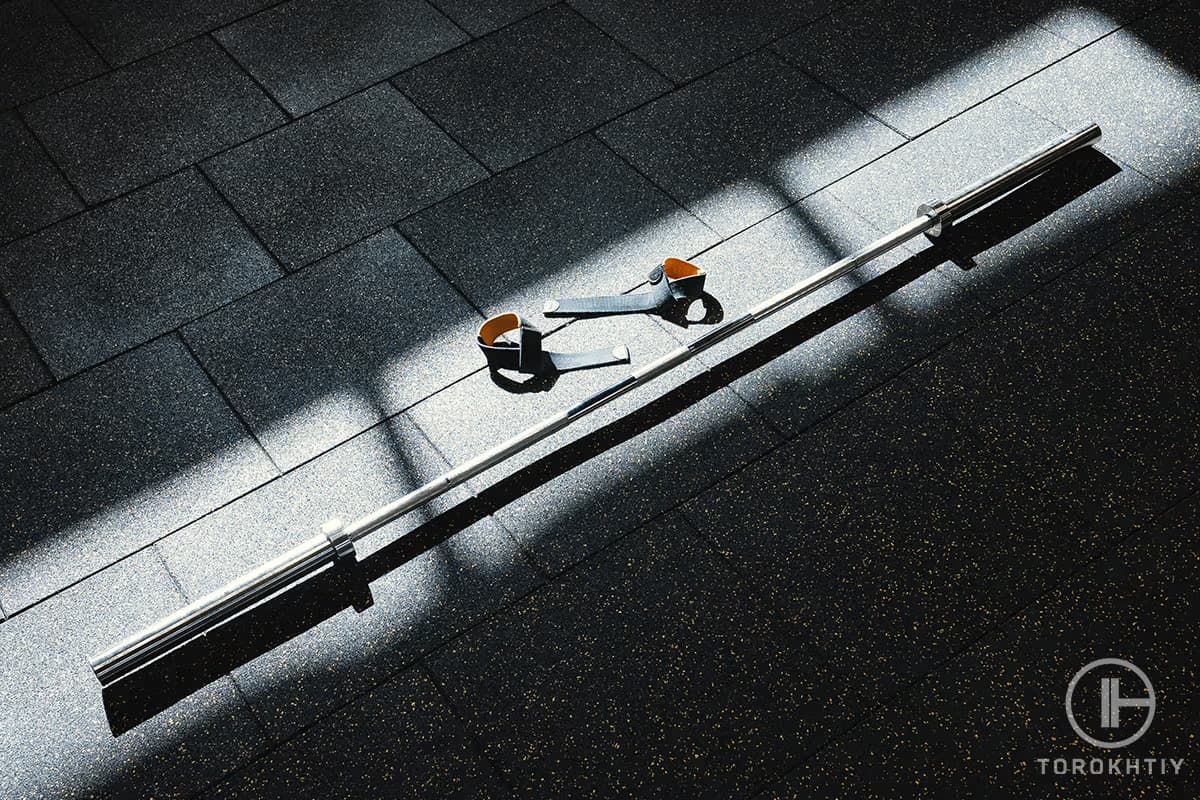
2. Olympic
Olympic barbells are designed for Olympic weightlifting (which includes the snatch and clean & jerk). The key differences between an Olympic bar and a straight bar can be weight capacity, whip, knurling, and approval for competition. They have standardized weight and size. Olympic barbells are known for their whip, which helps with lifting heavy weights explosively.
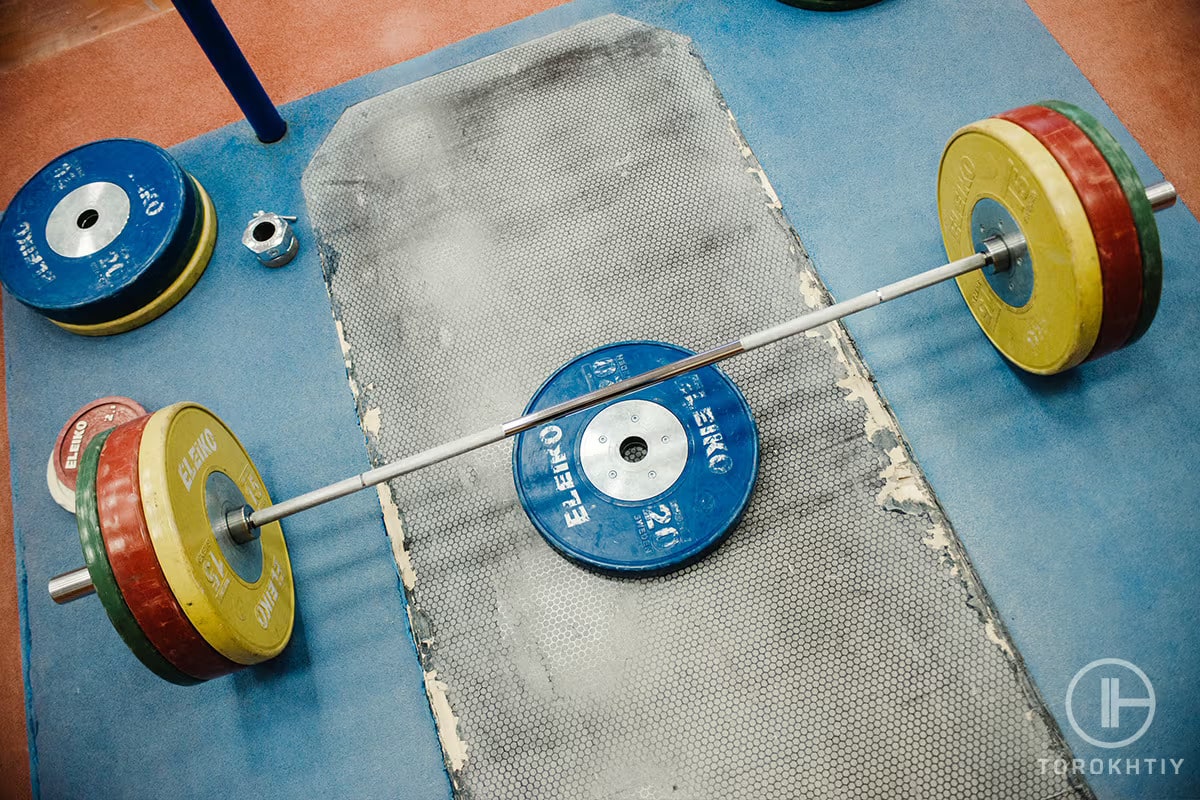
3. Powerlifting
Specially designed for powerlifting (squat, bench press, deadlift), these bars are stiffer than Olympic bars, they have more aggressive knurling for better grip, and they can be a bit longer sometimes. As far as the weight goes, it’s usually 20 kg for men and 15 kg for women.
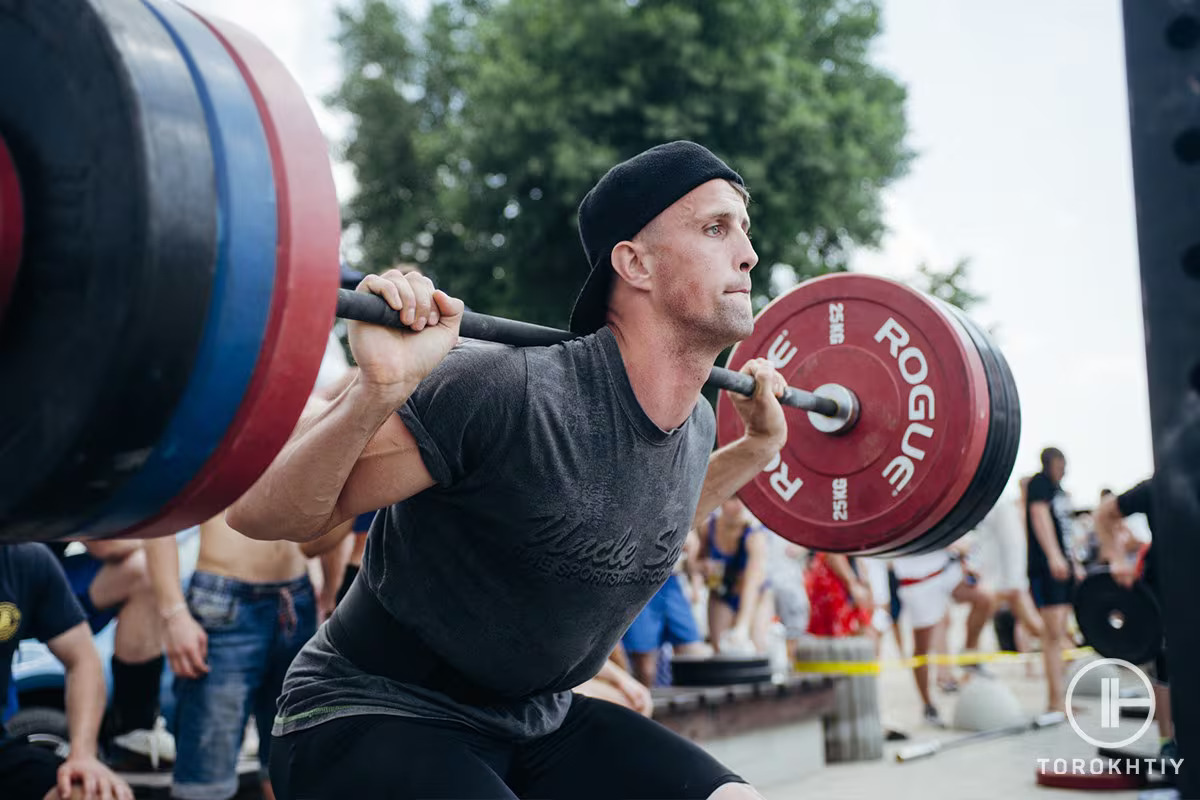
4. Fat Bars
Fat bars, also known as thick bars, have a larger shaft diameter, usually over 30mm. They’re great if you want to work on the strength of your grip or develop your forearms.
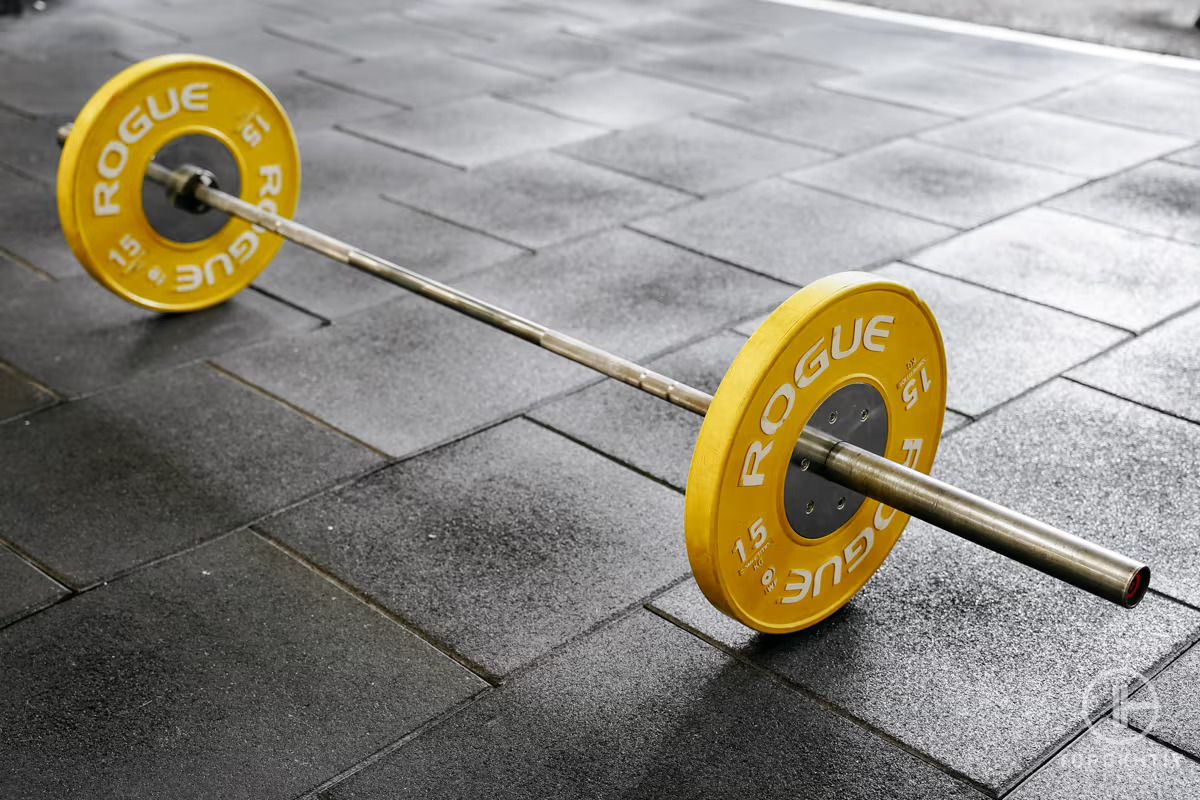
5. Trap Bars
You may have heard trap bars being called hex bars or shrug bars. The reason is their unique hexagonal shape with two handles on each side. They’re excellent for deadlifts, shrugs, and farmer’s walks. The unique design of trap bars can help you generate more power during lifts, but there’s a good chance it will tire you out more than a regular barbell would.
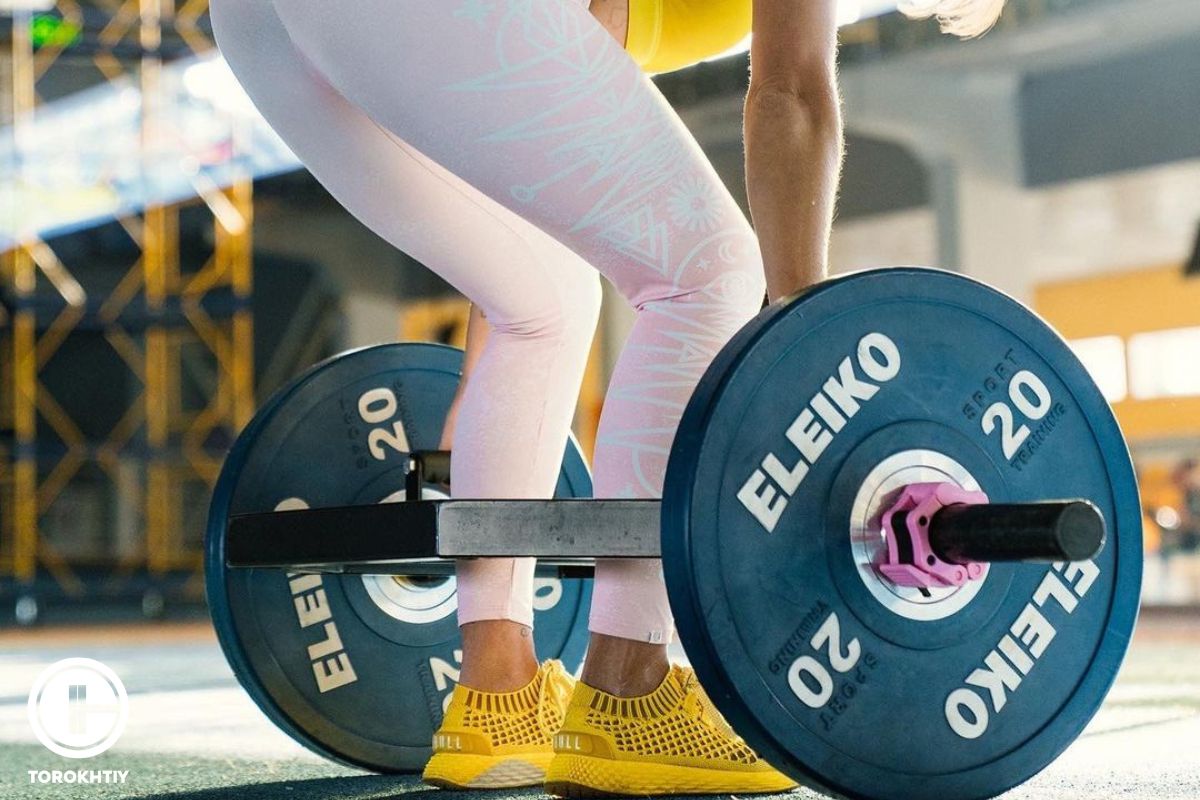
6. Technique Bar
They’re lightweight and shorter, usually with a smaller weight, like on our list that weigh 15 lbs. Technique bars are designed for beginners and those who want to practice their movements or perfect their form.
Our expert, Tanya Shaiko, proficiently stated:
“The most versatile barbell for home use is the standard steel barbell with standard diameters and a weight of 15 kg for women. It is suitable for many types of workouts. I recommend this one for beginners to start their training with.”
Olympic vs Standard Barbell: Main Differences
These are the most common and the most widely recognized types of barbells, and they differ mostly in purpose and specifications.
Like the name would suggest, Olympic barbells are primarily used in Olympic weightlifting. They can sometimes be longer, more flexible. The weight is always 20kg for men and 15kg for women. They have a 28mm or 29mm shaft diameter for men and 25 mm for women, rotating sleeves, which are important for dynamic movements like the snatch and clean & jerk. The knurling style is anywhere between aggressive and fine.
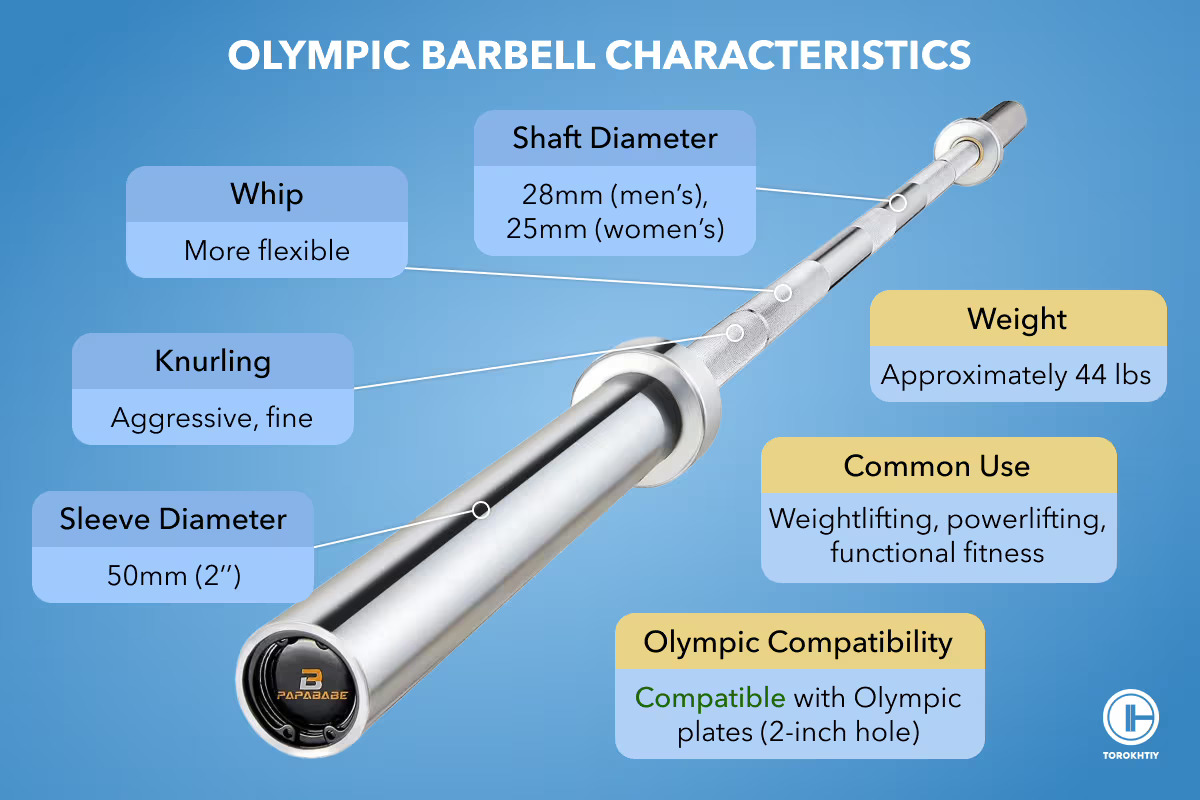
On the other hand, standard barbells are much more versatile and are what you’ll usually find in home and commercial gyms. They usually weigh around 44 lbs (20kg), have a shaft diameter of 28mm (sometimes 25mm with 33lbs bars, same as Olympic), and don’t always offer the same whip or sleeve rotation as Olympic bars. You won’t really find aggressive knurling on standard barbells – it’s usually moderate to fine.
In short, nowadays standard bars are pretty much the same as Olympic bars in terms of dimensions and weight. Most of the time, the difference can be in whip, spin, and weight capacity.
Sergiy Putsov, our PhD in Sports Science, noted:
“For a home gym, the best barbell is the one that’s versatile, of high quality and fits your training needs. I personally recommend a 20 kg Olympic barbell.”
Olympic bars are standardized – 20 kg for men and 15 kg for women (28 mm shaft diameter for men, 25 mm for women). Standard bars don’t have those requirements, but they’re still the same most of the time. But in case you are not looking for an Olympic barbell here you have a comparison between Olympic and Standard barbell that you can still buy.
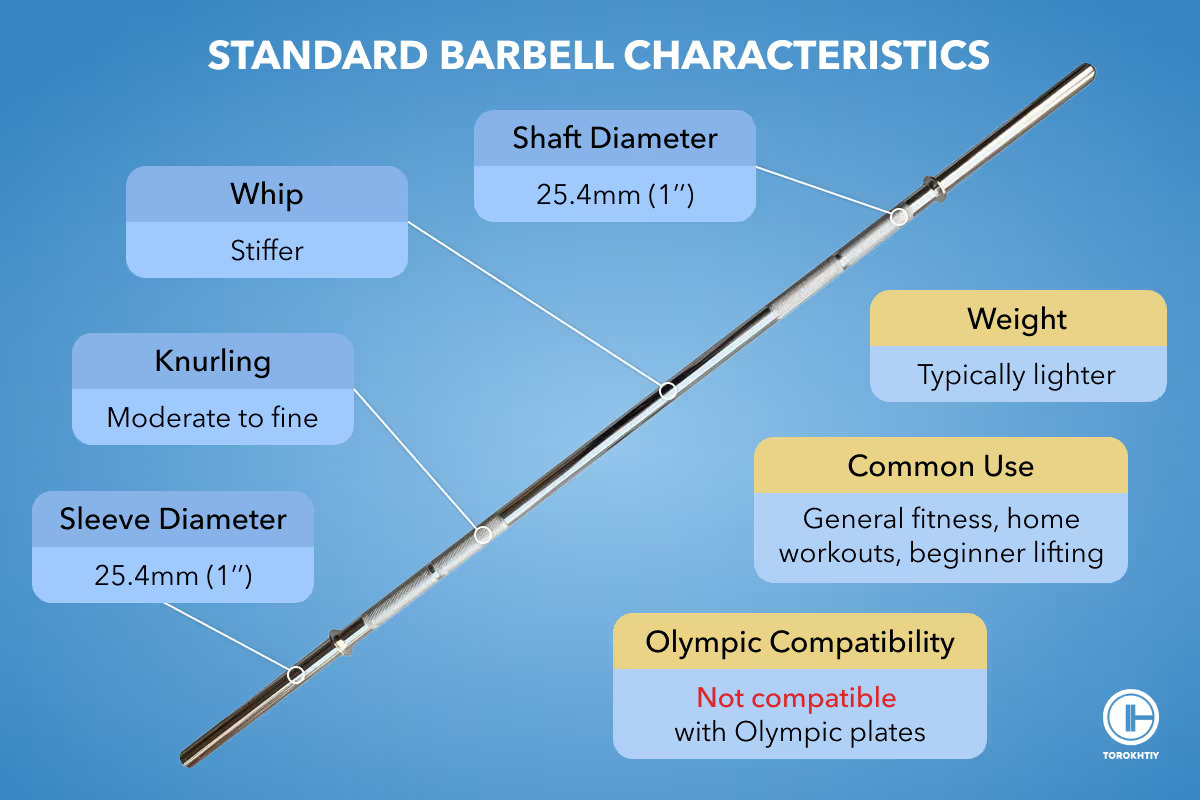
Men’s vs Women’s Barbell: Main Differences
Although there are people who don’t see the point in different barbells for men and women, the fact that this difference exists is very important. These gender-specific variations address the distinct biomechanics and the difference in strength between men and women and, ultimately, make weightlifting a more inclusive environment for strength training.
One of the key differences is, of course, the weight. Men’s barbells are heavier and usually weigh 44 pounds, while women’s barbells are lighter and weigh around 35 pounds. Men and women have different strength levels, so it’s important to recognize it and adjust accordingly.
Another really important difference is the thickness of the barbell’s shaft. Men’s barbells have a thicker shaft (about 28mm), which provides stability and a sturdy grip, especially for people with large hands. The shaft on the women’s barbell is usually thinner (about 25mm), which is more comfortable for people with smaller hands.
Knurling also varies, and men’s barbells have a rougher texture. This roughness provides a firm grip that’s necessary for heavy lifting. Women’s barbells have a smoother texture, which makes the grip gentler and more comfortable. This type of knurling suits more people, including beginners.
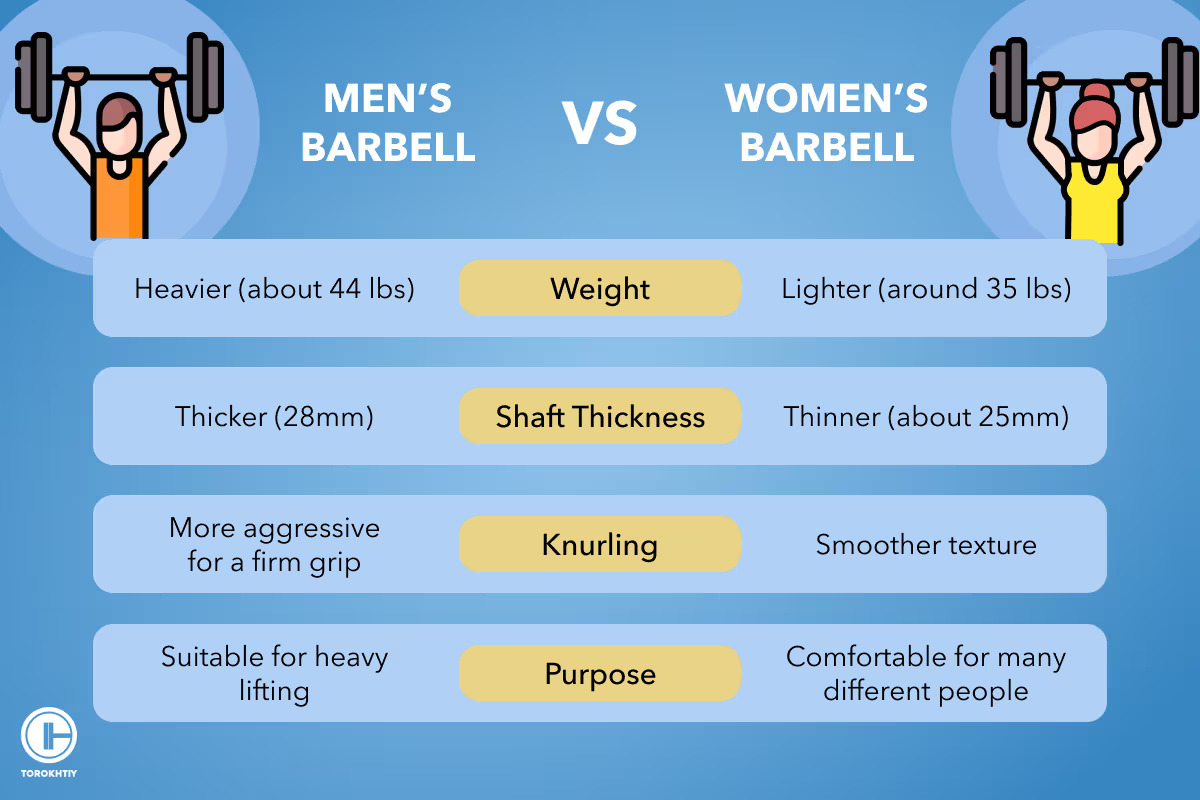
What to Look for When Choosing the Best Barbell?
Unless you’re looking at a specialty barbell, let’s face it – they all look very alike, at least at first glance, so it’s no wonder that making a decision can be stressful.
You should never get a barbell based only on the review. Yes, barbell reviews can be extremely helpful, but there are still things you need to pay attention to, so you know exactly what you’re getting and whether you’ll be able to use it properly.
Let’s go over the main things to look out for.
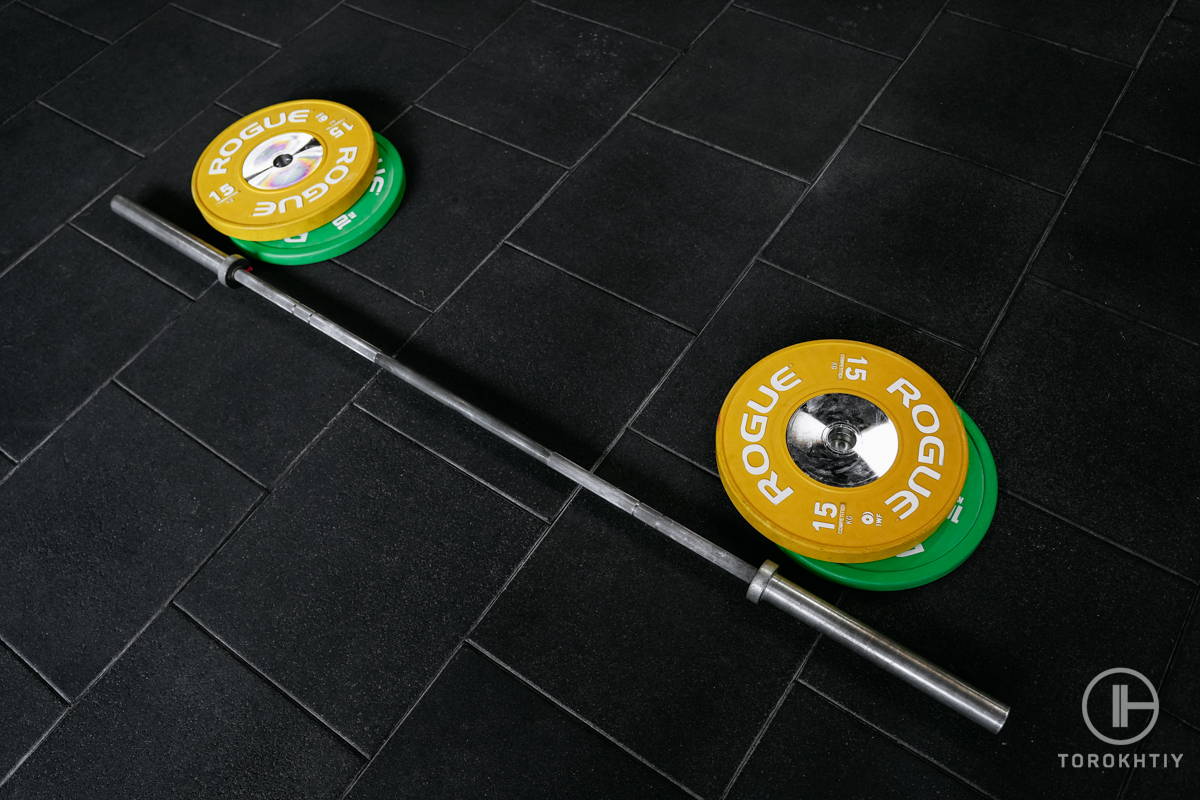
1. Material/Quality Ratio
The material the barbell is made of plays a huge part in how durable it is. Barbell shafts are usually made of steel, but the quality of steel and the craftsmanship are what you need to pay attention to. You want a high-end material and a barbell to be made precisely, with care, and by established barbell manufacturers.
2. Knurling Type
After the material, the next most important thing is knurling. Think about what you want to use the barbell for in order to determine what type of knurling you need. Olympic and powerlifting bars usually have more aggressive knurling because you need it for a secure hold during heavy lifts. General-purpose bars have a milder texture that still gives a decent grip, but that’s also suitable for high-rep exercises.
3. Diameter
The barbell diameter is another thing that’s going to impact your grip and, to some extent, the bar’s whip or flex. A thick shaft will give a sturdier grip, which can be good for heavy lifting, while a thinner shaft is more comfortable for people with smaller hands.
| Characteristic | Content |
|---|---|
| Material/Quality Ratio | High quality steel and craftsmanship from established manufacturers. |
| Knurling Type | Choose knurling based on lifting type. Aggressive for Olympic/powerlifting, mild for general use. |
| Diameter | Thicker diameter for sturdy grip, thinner for smaller hands. |
| Spin (Rotation System) | Smooth, consistent rotation and needle bearings for faster spin are important for Olympic lifts. |
| Coating | Affects corrosion resistance and grip. |
| Weight Capacity | Make sure the barbell can support the weight you plan to lift. |
4. Spin (Rotation System)
This is especially important for Olympic weightlifting. A good barbell has a smooth, consistent rotation and allows the plates to spin independently during lifts like the clean and snatch. Needle bearings provide a faster spin for dynamic movements.
5. Coating
The coating will affect how resistant the barbell is to corrosion, and it’s also going to affect the grip and overall aesthetics. Each type of coating has its pros and cons; for example, chrome offers excellent rust resistance but can be slippery, whereas bare steel provides an excellent grip but requires quite a bit of maintenance.
The Olympic Champion, Oleksiy Torokhtiy, added:
“When choosing your first barbell, you need to decide on the tasks, and what exactly you want to do with the barbell. I would certainly advise choosing something from the Olympic barbells, as they are suitable for both powerlifting exercises and functional training. Plus, the quality of those is usually top-notch.“
6. Weight Capacity
Each barbell has a set weight capacity, so make sure you choose one that can support the weight you plan to lift. This is particularly important for powerlifting and strength training.
Rogue Echo Bar 2.0
- Bar Weight: 20 kg
- Bar Length: 86.75’’
- Material: Steel
- Shaft Diameter: 28.5 mm
- Tensile Strength: 190,000 PSI
- Knurling Type: Multi (with Olympic knurl marks)
- Bearing/Bushing: Bushing
- Coating (finish): Bright zinc
- Center Knurling (yes/no): No
- Sleeve Diameter: 50mm
- Sleeve Length: 16.40’’
- Best Uses For: Multi-purpose (powerlifting, Olympic lifting, etc.)
- Maximum Load: No weight limit; you’ll likely run out of room before you reach the max capacity
- Warranty: 1 year
Rogue sets high standards for their equipment, and this barbell definitely lives up to the expectations. The 28.5 mm bushing is made with a lot of precision and assembled at Rogue’s factory in Columbus. This barbell is a balance of quality and good price – what more can you ask for?
The steel shaft has a tensile strength of 190,000 PSI, which isn’t the strongest on the market, but it can take intense workouts without problems. It’s good for a wide range of exercises, from powerlifting to Olympic lifts.
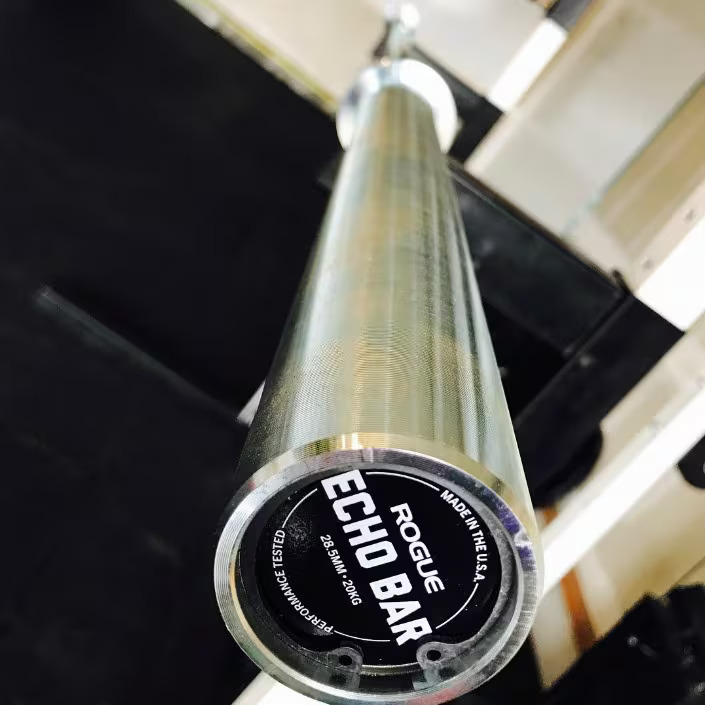
Something that pops out right away is the bright zinc finish. It looks fantastic, and protects the bar from corrosion and rust.
The snap ring sleeve construction gives a secure and stable fit for your weights, which, combined with the Echo branded endcaps, shows just how dedicated Rogue is to improving their products. The bar also has single IWF standard Olympic knurl marks that deliver the perfect amount of grip.
The sleeve rotation is smooth thanks to the bar’s bushing design and the spin is stable and consistent during lifts.
How to Maintain a Barbell: 4 Expert Tips
You can get a barbell made of the most durable and high-quality materials in the world, but if you don’t maintain it, it won’t last you as long as it should. Neglecting to maintain your barbell can also mess up its performance, so don’t skip it.
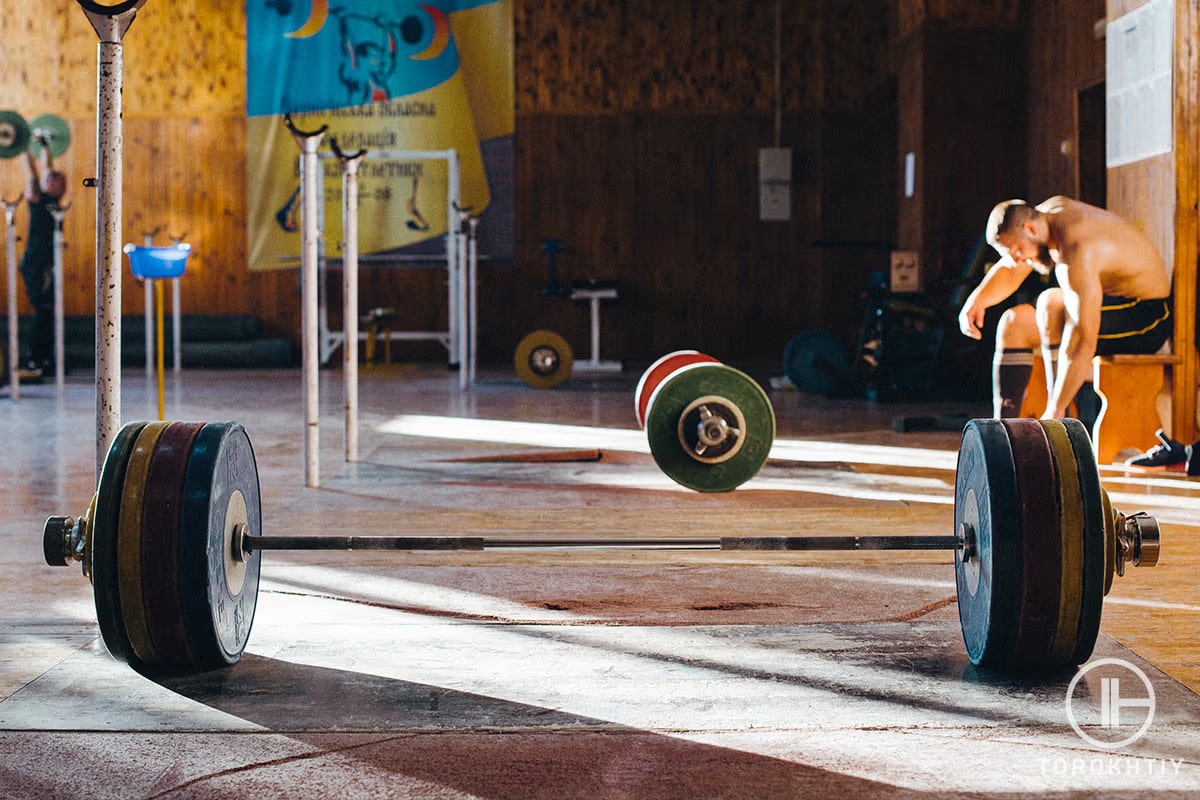
1. Prevent Corrosion
Corrosion is a common issue, especially for those who live in humid climates. Fortunately, there are ways to prevent it. Make sure to store your barbell in a dry place and, if it has a bare steel finish, apply a light coat of oil or specialized barbell protectant to the shaft.
For coatings like chrome or zinc, it’s enough to keep the barbell dry and clean — they won’t need any additional layer of protection.
2. Clean the Knurling
Chalk and sweat can make quite a buildup in the knurling, which will affect both your grip and the barbell’s performance. Use a stiff nylon brush to regularly clean the knurling and, for deep cleaning, use a barbell cleaning brush with nylon or brass bristles.
Tips From the Champ
The end caps, bolts, or other fasteners on your barbell may loosen up because of use and vibrations. Check them periodically and tighten them if you need to to make sure your barbell stays stable and safe to use. Doing this can also help prolong the lifespan of your barbell and maintain its performance.
Olympic Weightlifting Champion
3. Maintain Bushing/ Bearing
If your barbell has a bushing or bearing system in the sleeves (for spin), make sure to keep them well-lubricated with an oil specifically made to be used on barbells. This will keep the rotation smooth.
4. Storing a Barbell
Unless you want your barbell to get damaged or bent, you need to store it properly. Put it horizontally on a barbell storage rack or on J-hooks in a power rack. Don’t leave it loaded with plates for long periods of time, because that can lead to bending.
If you need to store your barbell and don’t plan on using it again for a long time, use barbell sleeves or wraps to protect the knurling.
| Characteristic | Content |
|---|---|
| Prevent Corrosion | Store in a dry place. Use oil / specialized protectant for bare steel. |
| Clean the Knurling | Use a stiff nylon brush for regular cleaning. For deep cleaning, use a barbell brush with nylon or brass bristles. |
| Maintain Bushing/Bearing | Keep well-lubricated with barbell-specific oil. |
| Storing a Barbell | Store horizontally on a rack or J-hooks. Use sleeves or wraps for long-term storage. |
FAQ
What Barbell to Get for a Home Gym?
This is something that’s going to depend on your fitness goals. For example, the Olympic barbell is a great choice if you want versatility. Whichever garage gym barbell you decide to get, make sure it’s made of high-quality materials and has a durable construction as well as the right knurling.
Is It Worth Buying a Barbell for Home?
It definitely is. A weight bar for a home gym is a very versatile way to do strength training and can help you save time and money in the long run because you won’t need a gym membership. For a home gym and personal use, a quality bar is a lifetime purchase.
What Barbell Should I Buy as a Beginner?
Start with a durable barbell that’s not too expensive and weighs 20 kg for men and 15 kg for women. You want a comfortable knurling pattern and a weight capacity that’s going to suit the amount of weight you intend to lift.
Conclusion
Buying a barbell can be stressful because it’s easy to get overwhelmed by the amount of available products.
As far as barbells go, however, your choice is now a little easier because you know what to look for, plus you have a recommendation for an excellent barbell if you don’t feel like doing your own research. The Rogue Echo Bar 2.0. It has everything you want in a barbell: high-quality materials, meticulous craftsmanship, excellent performance, and a reasonable price.
What do you have to add? Have you found the perfect barbell yet? What is the most important characteristic of a barbell, according to you? Do you have any barbell brands to recommend?
Leave your tips and thoughts in the comments section.
Happy lifting!
References:
- Antonio Bossio, C. Bitondo, Francesco Bellucci, Luigi Mollo, “Corrosion of Steel Arches in Support of Tuff Masonry. A Case Study,” EUROSTEEL 2014, September 10-12, 2014, https://www.researchgate.net/publication/260247601 (accessed Oct. 25, 2023).
- Douglas Fioranelli, C. Matthew Lee, “The Influence of Bar Diameter on Neuromuscular Strength and Activation: Inferences from an Isometric Unilateral Bench Press,” The Journal of Strength & Conditioning Research 22, no. 3 (2008): 661-666, https://pubmed.ncbi.nlm.nih.gov/18520435/ (accessed Oct. 25, 2023).
- Jason Lake, Freddie Duncan, Matt Jackson, David Naworynsky, “Effect of a Hexagonal Barbell on the Mechanical Demand of Deadlift Performance” Sports 5, no. 4 (2017): 82, https://www.mdpi.com/2075-4663/5/4/82 (accessed Oct. 25, 2023).
- “Knurling,” Wikipedia, https://en.wikipedia.org/wiki/Knurling (accessed Oct. 25, 2023).
- Paul A. Swinton, Arthur Stewart, Ioannis Agouris, W. L. Justin, Ray Lloyd, “A Biomechanical Analysis of Straight and Hexagonal Barbell Deadlifts Using Submaximal Loads,” Journal of Strength and Conditioning Research, 25, no. 7(2011): 2000-2009, https://journals.lww.com/nsca-jscr/fulltext/2011/07000/a_biomechanical_analysis_of_straight_and_hexagonal.31.aspx (accessed Oct. 25, 2023).
- Sandro Bartolomei, Giuseppe Grillone, Rocco Di Michele, Matteo Cortesi, “A Comparison between Male and Female Athletes in Relative Strength and Power Performances” J Funct Morphol Kinesiol. 2021 Mar; 6(1): 17, National Library of Medicine, https://www.ncbi.nlm.nih.gov/pmc/articles/PMC7930971/ (accessed Oct. 25, 2023).
- S. K. Singh, G. Alok, Rohan Ande, P. Sai Priya, “Materials Study on a Telescopic Barbell Design Using Finite Element Model,” IOP Conference Series Materials Science and Engineering 981, no. 4 (2022): 042031, https://www.researchgate.net/publication/347364498 (accessed Oct. 25, 2023).
- Photos are made by Torokhtiy Media Team.
Why Trust Us?
With over 20 years in Olympic weightlifting, strength training, nutrition coaching, and general fitness our team does its best to provide the audience with ultimate support and meet the needs and requirements of advanced athletes and professional lifters, as well as people who strive to open new opportunities and develop their physical capabilities with us.
By trusting the recommendations of our certified experts in coaching, nutrition, and sports training programming, as well as scientific consultants, and physiotherapists, we provide you with thorough, well-considered, and scientifically proven content. All the information given in the articles concerning workout programming, separate exercises, and athletic performance, in general, is based on verified data.
The product testing process is described in more detail here.
Author: Ihor Shymechko
Pro Olympic Weightlifter, Coach
Best Results: Snatch – 208 kg,
C&J – 240 kg
Ihor has been a professional weightlifter since 1996, boasting over two decades of competition experience. His notable achievements include clinching the European Championship in 2009 and securing a silver medal in the 105kg division at the Senior World Championships in 2011. Ihor represented his country in the 2008, 2012, and 2016 Summer Olympics. After retiring from competitive weightlifting, he transitioned to coaching, leveraging his vast experience to guide athletes who now compete on both national and international stages.
Reviewed by: Sergii Putsov
Head of Sport Science, PhD
Best Results: Snatch – 165 kg,
C&J – 200 kg
Sergii Putsov, Ph.D., is a former professional weightlifter and National team member, achieving multiple medals in the 94 kg weight category at national competitions. With a Master’s degree in “Olympic & Professional Sport Training” and a Sport Science Ph.D. from the International Olympic Academy, Greece, Sergii now leads as the Head of Sport Science. He specializes in designing training programs, writing insightful blog articles, providing live commentary at international weightlifting events, and conducting educational seminars worldwide alongside Olympic weightlifting expert Oleksiy Torokhtiy.




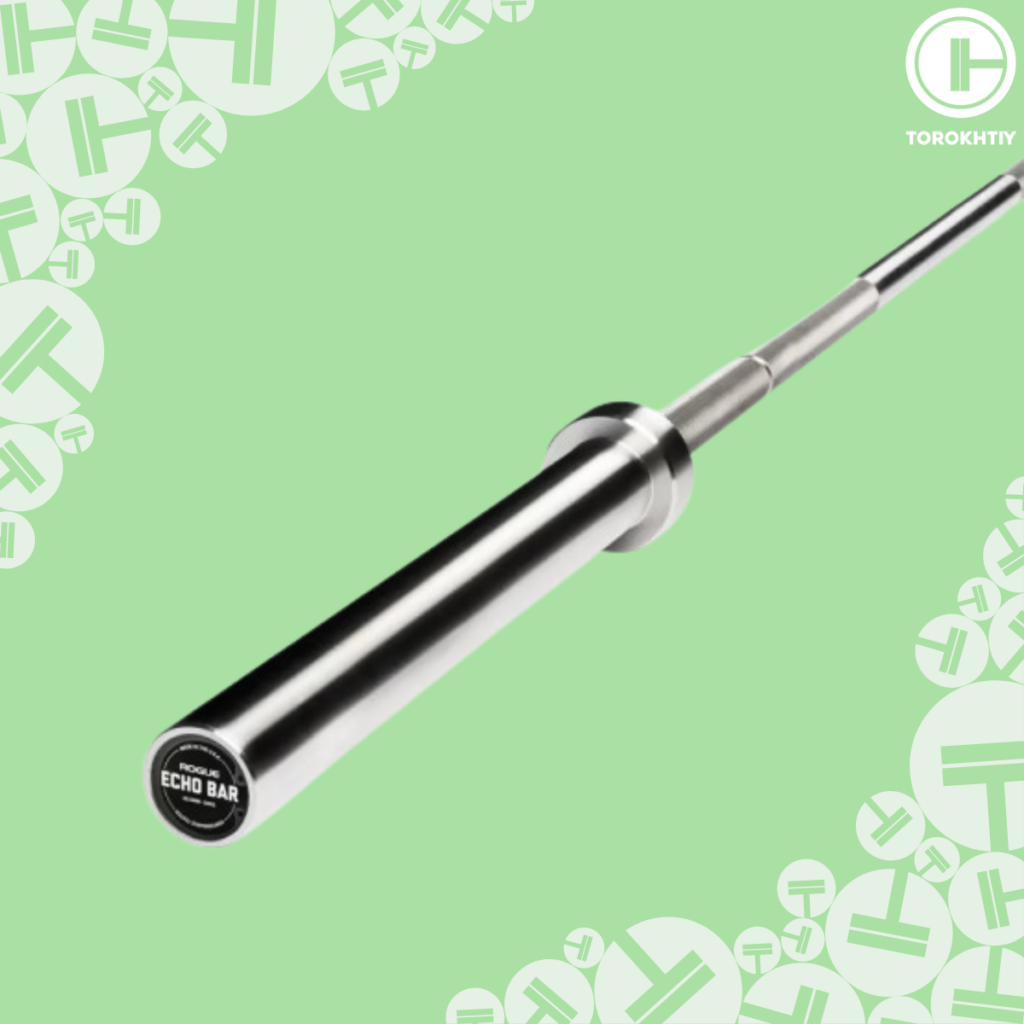

Still have questions after reading our article? Unlock your full potential by engaging with our experts and community! Don’t hesitate — leave a comment below and Ihor Shymechko will provide a personalized answer and insights to help you reach your goals.